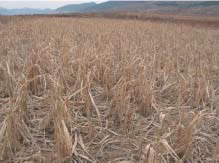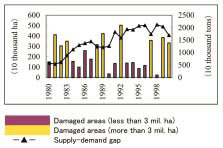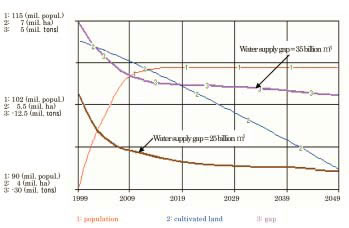Impact on food supply and demand due to changing water resources in Shandong Province, China
Description
[Objectives]
The diversification and modernization of farm production in China have increased the dependence on irrigation water. At the same time, growing demand for water from cities and township enterprises severely restrains the available water supply needed to improve farm production. While this water resource problem may not be easily solved, a quantitative analysis on the variation of water resources and its relation to grain production might elucidate an approach for improving the situation. Shandong Province, with a population of 90 million and a high economic growth rate, is one of the major agricultural production areas in China, and is suffering from a severe shortage of rainfall. Rainfall in the provincial capital Jinan in 2002 was only 382 mm, or merely 60 percent of the yearly average, causing grain production to decrease by as much as 20 percent from the previous year (Fig. 1). The present study employs a simulation model to analyze how the changing of water resources influences the grain production.
[Results]
In Shandong Province, the rate of drought-affected farm land during 1980's (averaged among the most severe drought years with a yearly damaged area above 3 million hectares) was approximately 3.45 million hectares per year. During 1990's, the rate increased to 4.16 million hectares per year. As a result, the yearly supply-demand (production and consumption) gap of these drought years (12.87 million tons) was 3 million tons more than that of the non-damage years (Fig. 2). Taking into account the decrease of agricultural land caused by future population growth, city expansion and industrial progress, as well as the influence of irrigation on the yield of grain production, simulation analysis on how the food supply-demand gap and water supply are related, was carried out using the system dynamic model.
Assuming an average yearly water supply of 25 billion m3, the food supply-demand gap will expand continuously and exceed 20 million tons in 2008 (Fig. 3). On the other hand, if it is assumed that the water supply will increase to 35 billion m3 (the minimum water demand in 2030 in Shandong Province is predicted to be 33.5 billion m3), the food supply-demand gap will then be reduced by an amount predicted not to exceed 10 million tons. If the supply-demand gap is not reduced by significantly increasing water supply, the possibility of the province losing its status as a major grain production area will continue to remain high.
Figure, table
-
Fig. 1. Corn affected by drought in Shandong Province, China. -
Fig. 2. Area of damage caused by drought and prediction of food supply-demand gap.
Note: Grain products include cereal, tubers and beans. Colors in the demaged areas over 3 million hectares are yellow. Source: "China Statistical Yearbook (1990-2001)", "China Rural Statistical Yearbook (1985-2001)". -
Fig. 3. Changes in the food supply-gap according to quantity of water supply.
- Affiliation
-
Japan International Research Center for Agricultural Sciences Development Research Division
- Classification
-
Technical A
- Term of research
-
FY2001 (FY1999-2001)
- Responsible researcher
-
CHIEN Hsiaoping ( Development Research Division )
KOYAMA Osamu ( Development Research Division )
- ほか
- Publication, etc.
-
Chien, H. P. (2002): An analysis of food production and agricultural resource change. Japanese Journal of Farm Management, 40-1, 152-155 (in Japanese).
Yulin, S. and Liangshu, L. (2001): Water demand and saving water technologies in agriculture in China. China Water Public Press (in Chinese).
Ruth, M. and Hannon, B. (1997): Modeling dynamic economic systems. Springer-Verlag New York, Inc.
China Statistics Press (2000): Shandong agricultural statistical yearbook (in Chinese).
Water resources bureau of Shandong province (1993): Water resources and supply in Shandong province 1987- 1992 (in Chinese).
- Japanese PDF
-
2002_02_A3_ja.pdf787.34 KB
- English PDF
-
2002_02_A4_en.pdf68.96 KB



